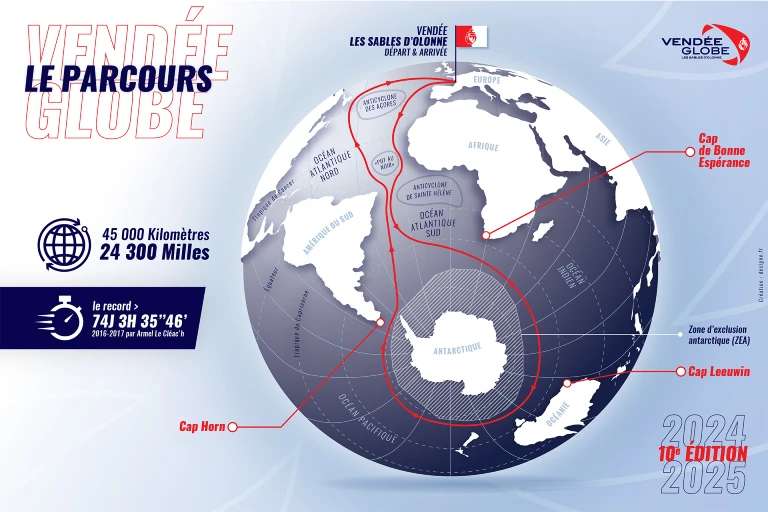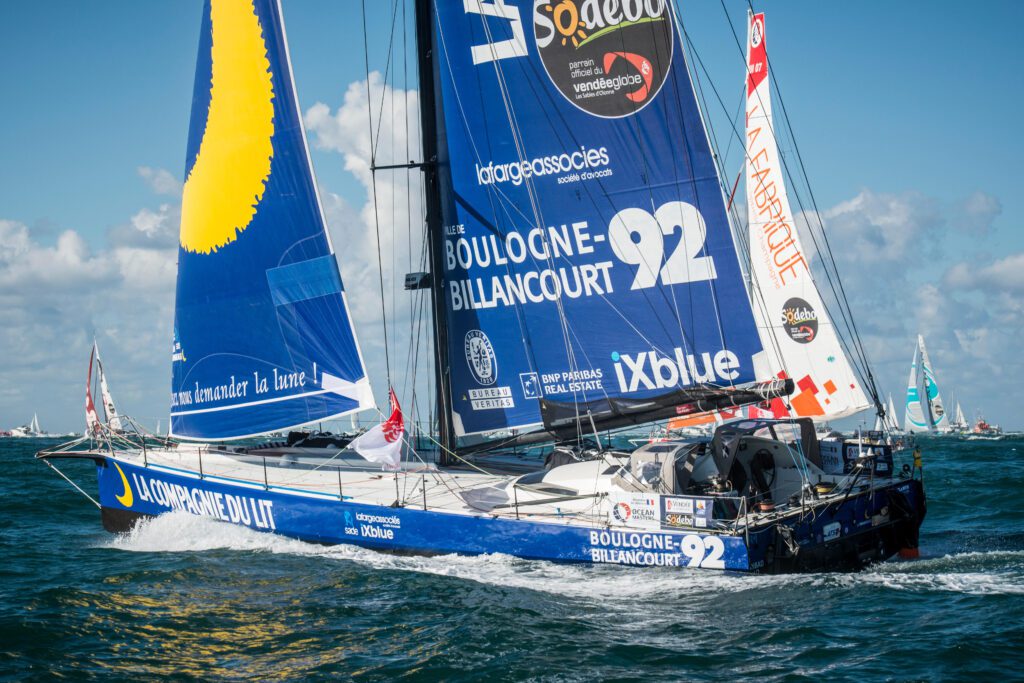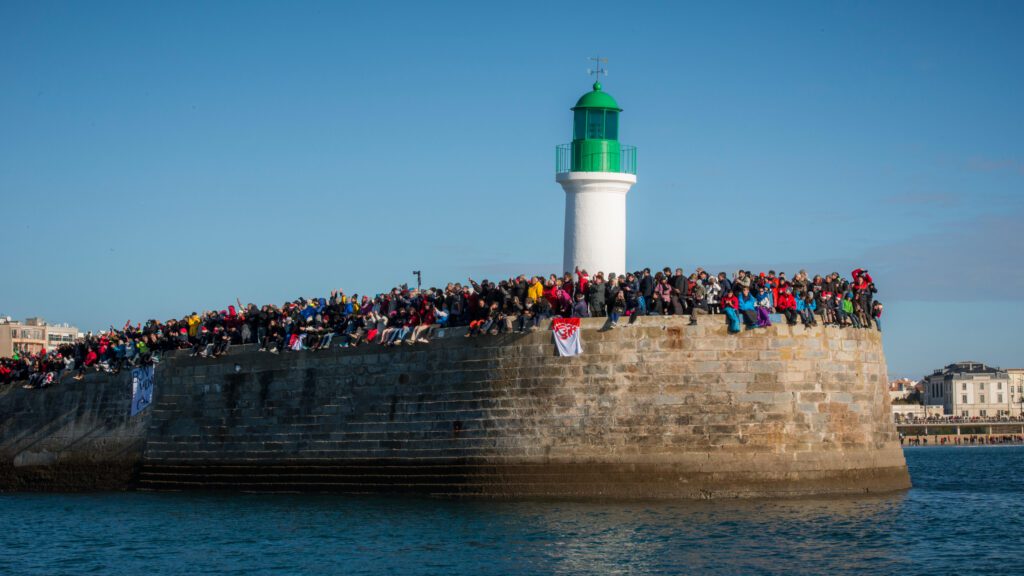Publication date: 29/10/2024
The tenth edition of the Vendée Globe will start in Les Sables d’Olonne on Sunday, November 10, 2024. In this article, Port Adhoc looks back with readers at this great ocean race, considered to be the greatest sailing race around the world.
What is the history of the event? What are its main principles, and which sailors have distinguished themselves? How can you watch the start of the Vendée Globe 2024 from the comfort of your own boat?
A nautical event since 1989
There had already been a few ocean races around the world. But on November 26, 1989, when the competitors in the first edition of the Vendée Globe set sail, it was officially the first single-handed, non-stop round-the-world sailing race. On that day, 13 sailors set sail from the port of Les Sables d’Olonne in the Vendée. Only 7 sailors completed the race, returning to the same port more than three months later.
Since the first Vendée Globe in 1989, nine editions of the event have already taken place – always starting from the Vendée port. In all, over 35 years, 200 sailors have taken part in the race. Proof of the complex nature of the Vendée Globe, only 114 competitors have reached the finish line, each time after an extremely difficult circumnavigation.
A single-handed, non-stop, unassisted performance
The Vendée Globe is an extraordinary event, during which competitors are subject to very strict regulations, which also contribute to the race’s reputation:
- The Vendée Globe is a mixed competition in which only the skipper of the boat is authorized to be on board. No other person is allowed on board, for any reason whatsoever. The only exception to this rule is if it is necessary to assist another competitor.
- Race regulations also prohibit competitors from stopping ashore: sailors are allowed to stop for a while, at anchor for example, but are not allowed to go ashore “beyond the limit of the foreshore”. Nor are they allowed to dock with another boat – again, except with the intention of carrying out a rescue for another sailor.
- On board their boats, Vendée Globe participants can only rely on themselves. Weather routing, in particular, is strictly forbidden. Sailors make all navigation and routing decisions themselves, without outside assistance. In the event of damage on board, they are also the only ones able to intervene technically – possibly after consulting the ship’s architect or their technical team. Finally, in the event of injury or illness, sailors are also responsible for self-care. If necessary, they can call on the assistance of the race doctor.
A race route around 3 capes and across 3 oceans
Perhaps the greatest difficulty of the Vendée Globe lies not in these rules, but in the course itself, which is renowned for being extremely difficult.
In each edition, after setting out from the port of Les Sables d’Olonne, the competitors begin by sailing down the Atlantic Ocean, before crossing the Indian and Pacific Oceans. Finally, they head back up the Atlantic, before completing their loop by returning to Les Sables d’Olonne. Three mythical capes punctuate the entire race: Cape of Good Hope – in South Africa, Cape Leeuwin – in Australia, and Cape Horn – in Chile.
This course requires sailors to confront the harshest elements on our planet. Around the world, they encounter wind shifts, contrary breezes, stormy lows, the St. Helena and Azores anticyclones, the Doldrums… all elements which, for almost 3 months, constantly challenge their vigilance, as well as their physical and adaptive capacities.

A long sail with wind, waves, swell and ice
For each edition of the race, the management plans a course of 45,000 kilometers, or 24,300 nautical miles around the world. In practice, it’s often more: the sailors must constantly adapt to the weather systems and phenomena encountered, which has a real impact on the boats’ trajectories. It’s not unusual for competitors to sail much longer distances – up to 52,000 kilometers, or 28,000 nautical miles, for some!
A race to make ocean racing history
For sailors, the Vendée Globe is already a podium in itself: access to the race testifies to the competitors’ great skill, determination and tenacity. Taking part in the event is always a way of demonstrating incredible performance.
The winners, on the other hand, etch their names in the history of ocean racing and sailing in general:
- Titouan Lamazou in 1990,
- Alain Gautier in 1993,
- Christophe Auguin in 1997,
- Michel Desjoyeaux in 2001,
- Vincent Riouen 2005,
- Michel Desjoyeaux (again!) in 2009
- François Gabart in 2013,
- Armel Le Cléac’h in 2017,
- Yannick Bestaven in 2021.
Among these 9 personalities, Armel Le Cléac’h – winner of the 8th edition of the Vendée Globe, holds the time record: 74 days and 3 hours.
This year, will a sailor be able to complete the solo, non-stop, unassisted round-the-world race more quickly?
Boats with the same characteristics
To ensure a level playing field for all sailors, they all compete on the same boats: 60-foot monohulls – or 18.28 meters long – with a 4.50-meter draught. Highly canvased and extremely powerful, they can reach speeds of up to 40 knots (74 km/h) downwind!

Attend the start of the Vendée Globe 2024 with your ship
If you would like to experience the start of this year’s Vendée Globe at sea, aboard your own boat, there are several things you need to know:
Firstly, please note that the two entrances to Port Olona and Quai Garnier, in Les Sables d’Olonne, will not be open to boaters. The relevant port authorities advise those wishing to stop over to contact neighboring marinas: Port La Vie in Saint-Gilles-Croix de Vie, Port Bourgenay in Talmont-Saint-Hilaire, Les Minimes or the Vieux-Port in La Rochelle.
And don’t forget that it’s also easy to reach the event from Charente-Maritime: within our network of ports and marinas, Port Adhoc Soubise is just 50 nautical miles away!
On the day of departure, Sunday November 10, 2024, all crews will be required to comply with specific instructions issued by the Affaires Maritimes. Certain navigation zones, in particular, will be imposed on boaters. All those wishing to attend the start of the Vendée Globe at sea aboard their vessel are invited to consult the sailing instructions, which will be available on the race website a few days before the event.

